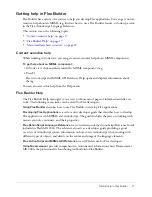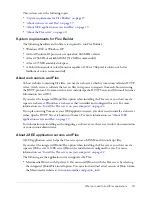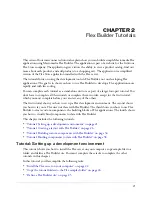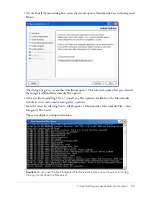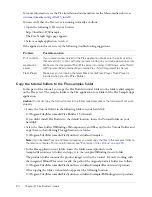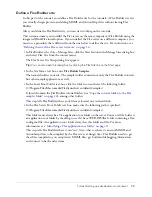
Starting a new application in Flex Builder
11
6.
In the URL Prefix text box, specify the URL prefix that Flex Builder should append to Flex
file names.
To get a file compiled at design time, Flex Builder sends the file to the Flex application root
folder and then attempts to request it using a URL—in effect Flex Builder becomes a client.
Flex Builder deduces the correct URL by combining the URL prefix you specify with the file
name.
For example, if your application’s URL is www.macromedia.com/flex/start.mxml, you enter
the following URL prefix in the Testing Server category:
http://www.macromedia.com/flex/
If Flex Builder runs on the same computer as your Flex server, you can use localhost for your
domain name, as follows:
http://localhost:8700/flex/
Note:
The default port number is 8700. If you changed it during installation, use the appropriate
number in the URL prefix.
For more information on setting the Testing Server category options, click the Help button on
the dialog box.
7.
Click OK to define the Flex Builder site and dismiss the Site Definition dialog box, and then
click Done to dismiss the Manage Sites dialog box.
You can now start developing your application with Flex Builder.
Related topics
•
“Tutorial: Setting up a development environment” on page 21
•
“Specifying where dynamic pages can be processed” in Using Dreamweaver Help.
Identifying a Flex application root folder
You must specify a valid Flex application root folder when defining a Flex Builder site. Flex
Builder puts files such as MXML, ActionScript, CSS, and image files in this folder in order to run
and debug files at design time. If the folder is not a valid application root folder, Flex Builder will
not work properly.
To identify a folder as a Flex application root folder:
•
Look for a WEB-INF/flex/ subfolder with a flex-config.xml file in it.
A Flex application root folder always has a WEB-INF/flex/ subfolder with a flex-config.xml file
in it. For example, if you’re using JRun 4 as the J2EE server, the application root folder is as
follows:
jrun_root
/servers/
server
/
Flex_app
where
jrun_root
is the J2EE server’s root folder,
server
is the name of a defined JRun server
(such as “default”), and
Flex_app
is the application root folder. The
Flex_app
folder must
contain a WEB-INF/flex/ subfolder with a flex-config.xml file in it, as follows:
Flex_app
/WEB-INF/flex/flex-config.xml
Summary of Contents for FLEX BUILDER-USING FLEX BUILDER
Page 1: ...Using Flex Builder...
Page 116: ...116 Chapter 4 Building a Flex User Interface Visually...
Page 144: ...144 Chapter 6 Working with Data...
Page 154: ...154 Appendix A Basic Flex Concepts...

















